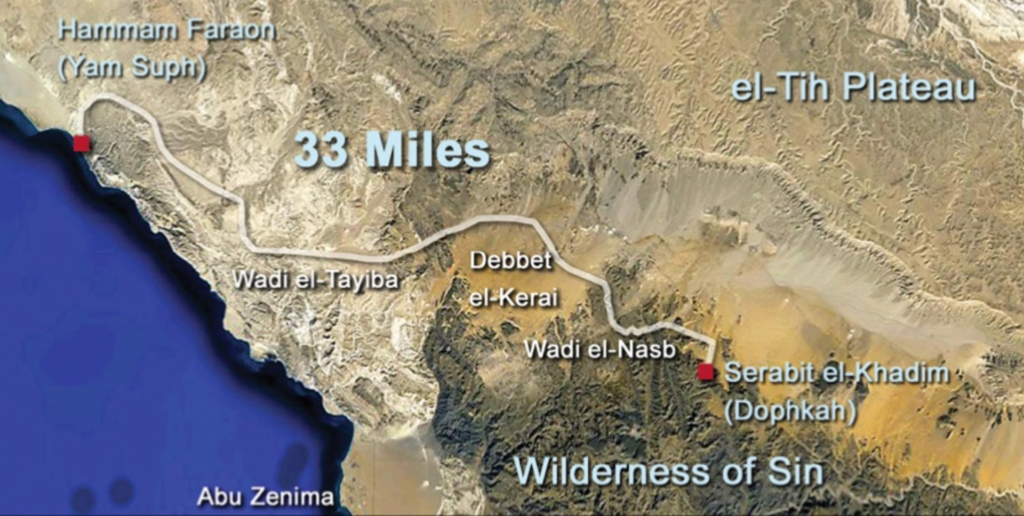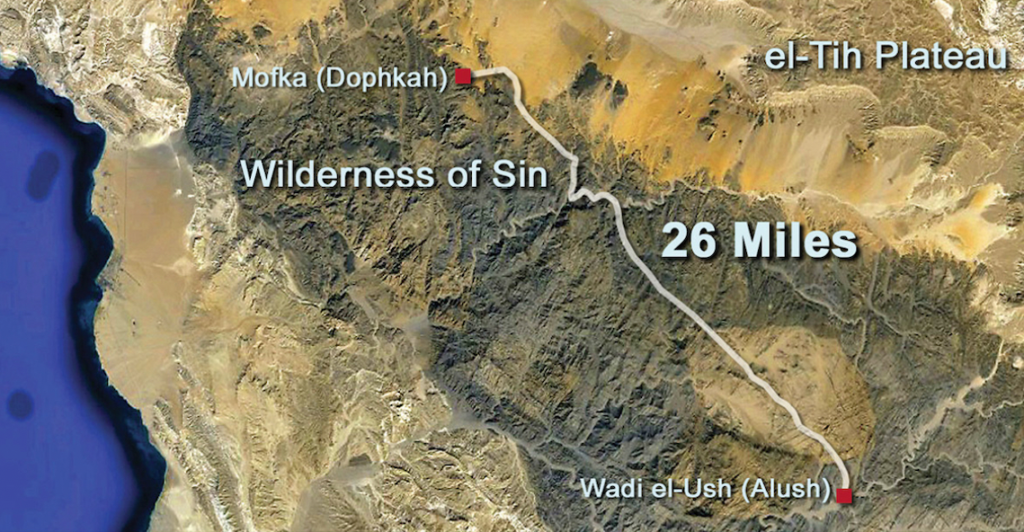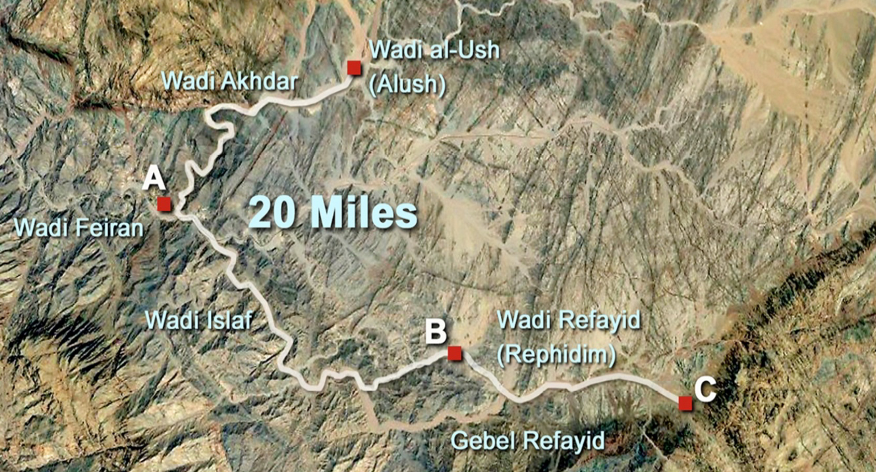I left you at the end of the last Nugget with us arriving at Dophkah (Serabit el-Khadim). At the time of the journey outlined in the book of Exodus, Serabit el-Khadim (Sarbut al-Khadem) was a principle mining centre for turquoise and other treasures. The name now in modern Arabic is called Mofkat. According to David Rohl the similarity between toponyms throughout this whole route is remarkable in terms of the linguistic correlation between ancient and modern place names (toponyms).
- Dopkah ~ Mofkat
- Alush ~ Wadi al-Ush
- Paran ~ Wadi el-Feiran
- Wadi er-Refayid (Robinson’s Rudhwah gorge) ~ Rephidim

I call Sarbut al-Khadem alias Serabit el-Khadim alias Dophkah a gold standard location because of its connection to the mining centre in the time of Amenemhat III and the link to Joseph and his work co-ordinating the canal and water retention projects in that same time frame. Not only that but this area is remarkable for the development of a phonetic alphabet in ancient times. See the Nuggets I wrote on the evidence [type <alphabet> into the search engine on this website]. Douglas Petrovich has linked the development of phonetic alphabets to the Israelites and David Rohl suggests Joseph is most likely candidate given his education and cultural connection to Egypt and hieroglyphs. The evidence is strong. See also the details I included in the Evidence for the Exodus series in the Found at Sarbut al-Khadem Nugget. Any route suggested as a potential route for the Exodus journey ought to pass through this region. The strength of historical links found in the area and connected to the Israelites almost makes it mandatory. However, as I have explained before, the other aspect to this is the fit to the timing of the journey and the distances involved matching the biblical text is what motivated David Rohl to make the journey with a view to testing the distances involved and the match to a large group of people walking the same route.
According to David Rohl the connection to the writing in the Valley of the Writing is unlikely to be written by the fleeing Israelites and more likely to be left by the Nabateans during the Nabatean Kingdom from 4 BC to the 2nd Century AD (or CE as is used now). This makes more sense to me as I have always wondered why the fleeing Israelites would take the time to carve such messages on the rocks when they were enroute to the Paran. Furthermore David Rohl suggests the characters used is more likely that used by the Nabateans than the time frame of the Israelites during the Exodus in 1650 BC and the Middle Bronze Period. There is much more to say about this at a later date. Several scholars are soon to release material on these findings. But everything fits in with the locations in this area delineated on the maps.

There are hundreds of inscriptions found on the rocks between Serabit el-Khadim (Dopkah) and the region of Alush. To negotiate this portion of the journey David Rohl stated they needed to take two days to go around the area indicated on the map below in 4WD vehicles given the rocky nature of the landscape. Robinson and Smith travelled on foot more directly from Alush to Refayid which is likely to be the route the Exodees took. Robinson named the region to the east of Wadi Islaf the ‘Rudhwah Gorge’. Rephidim is a plural Hebrew form of the name which if made singular matches the Arabic Refayid.
The locations marked A and B are the likely alternatives for the battle recorded with the Amelakites in Exodus 17, the chapter which records both the battle and the provision of water at Rephidim. James Hoffmeier also believes this to be the location of biblical Rephidim as the wells and water found there are plentiful and sweet compared with drier end of the valley at Wadi Feiran. Besides there is a rocky hill at the possible battle site B where the hill stands out as a lookout above the broad sandy plain which seems to the David Rohl to be the perfect place where Moses would have held his arms loft as the battle raged.

Once we arrive at this point we are within a day’s journey of Mount Horeb or Mt Sinai. The two prime peaks for the choice of Mt Sinai, the Mountain of God, in this area are Gebel Safsafa or Gebel Musa. I will leave you again at this point within striking distance of the peak we are seeking. The time taken to get from Pi-Rameses (Avaris) to Mt Horeb or Sinai was 47 days in all. We will settle in here and take stock of the onward journey from this point. The Israelites camped at Mt Horeb or Mt Sinai for a year before moving on. They were told by the LORD through Moses to stay here until the Pillar of Cloud and the Pillar of Fire moved them on. We too will pause at Mt Sinai and put some pieces together before we attempt to plot the remainder of the journey to Kadesh Barnea in the Wilderness of Paran.
The locations from Mt Sinai onward are problematic. David Rohl is the first to attempt to plot the journey from this point onward. Most researchers adopt the view of William Dever and Kenneth Kitchen that all locations from this point on can only be conjecture. Steve Rudd is one who has come up with some of the locations listed in the Numbers 33 list in the region to the east of the Gulf of Aqaba. You will note that Rudd’s Itinerary for taking those who join him on a 47 day journey, actually matches the 47 days taken to get from Avaris (Tel ed Daba’) to Mt Sinai. However the earlier locations of the places closer to Avaris or Pi-Rameses in Egypt, namely Succoth, Etham, Migdol, Baal Zephon and Pi-Hahiroth as marked on Rudd’s map stretch the imagination too much for such places to be located close to the Straits of Tiran. As I have stated before the key to all of this making sense in lies in soundness of the total pattern of evidence, the one thing which Timothy Mahoney has picked up in his video series on the Patterns of Evidence. For any of it to fit; all of it must fit. That is our challenge.
I will give you the standard location for Mt Sinai in the next Nugget and then we will move on from that point following the route David Rohl suggests from that point on, uncharted territory thus far. You be the judge as to whether the pieces fit or not. Ask your questions along the way. You will help me to keep all of this aligned in the attempt to arrive at a conclusion which fits the facts. I am not pushing a barrow on this journey, I am simply seeking to see if all the facts fit logically and explain the biblical text.
